2. 江苏省地理信息资源开发与利用协同创新中心, 江苏省环境演变与生态建设重点实验室, 江苏省水土环境生态修复工程实验室, 南京 210023;
3. 华东师范大学计算机科学与软件工程学院, 上海 200062
2. Jiangsu Center for Collaborative Innovation in Geographical Information Resource Development and Application, Jiangsu Key Laboratory of Environmental Change and Ecological Construction, Jiangsu Engineering Laboratory of Water and Soil Eco-remediation, Nanjing 210023, China;
3. School of Computer Science and Software Engineering, East China Normal University, Shanghai 200062, China
湖泊是地球表层系统中各个圈层相互作用的联结点, 对区域乃至全球尺度上的物质循环具有重要的意义[1].尽管全球湖泊面积占陆地面积不足2%, 但是湖泊有机碳年埋藏量却相当于海洋的50%, 是全球重要的有机碳存储场所[2, 3].湖泊沉积物不仅收纳了大量来自陆地生态系统的有机碎屑, 而且湖泊较高的生物生产力、较强的生物泵功能, 带来较快的生物源碳沉积, 对于湖泊沉积物中营养盐循环、污染物的迁移转化以及全球气候变化都具有重要的影响[4, 5].
湖泊沉积物中不同来源的有机质与元素生物地球化学过程联系紧密, 对底栖生物的组成、分布及新陈代谢, 碳的转化速率等都存在影响[6], 还能够有效指示沉积物营养状况及人类活动对湖泊的干扰强度[5].研究表明, 不同来源有机碎屑的分解速度和分解度差异很大, 在适宜的气候条件下, 藻类碎屑4天内就可以分解物质干重的50%, 而水生植物碎屑残体通常需要0.5~12个月[7, 8].与藻类腐解过程不同, 水生植物碎屑残体腐解过程包括初期易溶解碳水化合物的快速溶解、释放, 进而难分解物质木质素、纤维素等不断积累, 在微生物及胞外酶作用下缓慢分解, 分解速率明显减慢[9].同时, 沉水植物在秋、冬季进入衰亡期后, 碎屑残体腐解相对缓慢, 当气温回暖后, 由于微生物活动分解加速, 一部分营养盐在短期内释放进入水体, 参与水体营养再循环, 部分营养盐向底泥迁移或在微生物作用下以气体形式从水体逸出[10].此外, 在沉降及埋藏过程中, 有机碎屑的组成及活性不断发生变化, 其中活性有机质优先降解[11], 例如色素, 糖类, 蛋白质, 脂类等, 而腐殖质等难降解有机质最终被埋藏保留在沉积物中[12].可见, 湖泊沉积物有机质的沉积与降解变化会直接影响碳埋藏状况.在太湖、洪泽湖等湖泊的湖滨或湖湾局部区域有机碎屑残体淤积厚度可以达到1 m左右[13~15].表层沉积的碎屑残体多呈黑色, 有机质和水分含量高, 分解耗氧致使水体缺氧水质恶化, 残体淤积导致湖底抬升, 加速湖泊沼泽化[16].
目前富营养化湖泊藻类、水生植物碎屑残体堆积对生源要素氮、磷和黑臭物质的影响已经有较多研究[17~19].然而, 在气候变化和富营养化双重影响下, 湖泊水生植物碎屑经过快速搬运和堆积形成水生植物碎屑堆积层不同于缓慢的自然沉积形成的沉积物, 该堆积层的物质组成、有机质分布和腐解产物的赋存形态目前尚缺乏了解, 故阐明水生植物碎屑堆积层的物质组成对湖泊沉积物碳生物地球化学循环过程具有重要意义.为此, 本研究选取太湖胥口湾为研究区域, 在离岸不同距离和不同水生植被分布区采集沉积物柱状样, 探究沉积物中碳、氮、磷、色素以及生物易降解有机质的组成和空间分布规律, 以期为太湖富营养化控制与生态修复提供理论指导.
1 材料与方法 1.1 点位布设与样品采集于2018年10月, 在太湖水生植被丰富的草型湖区胥口湾, 利用沉积物柱状采样器(φ=9 cm, H=100 cm)采集沉积物样品, 从湖滨带向远岸带延伸, 每隔2~3 km设置一个点位, 共设置7个点位(图 1), 每个点位不同位置采集3根柱状样, 现场严格按照每2 cm分层, 并将同一层沉积物样品混匀装入自封袋中, 同时利用便携式水质测定仪(ProODO/Pro10/Pro30, 美国YSI公司)测定水体溶解氧(DO)、氧化还原电位(ORP)和电导率(EC)等理化指标, 并记录水深及水生植物分布情况(表 1), 全部样品当天运回实验室冷藏保存.
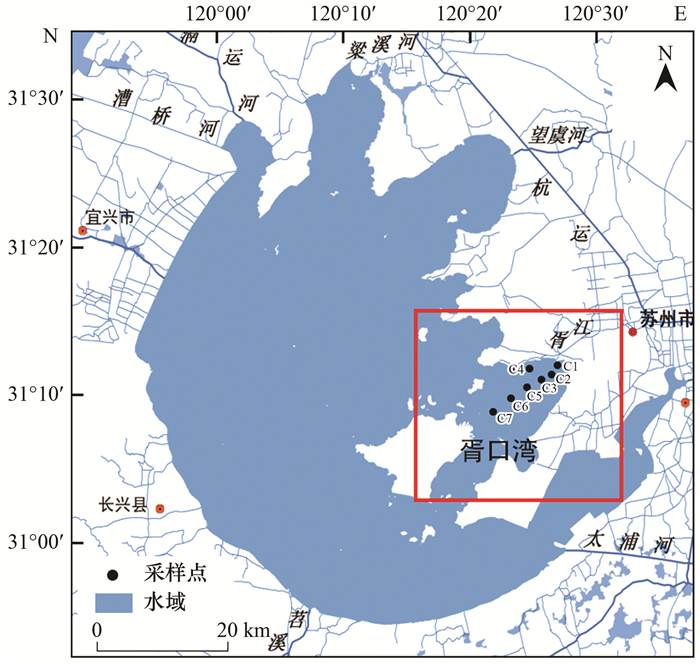
|
图 1 采样点位示意 Fig. 1 Map of the sampling sites |
|
|
表 1 采样点位概况与水生植物分布特征 Table 1 Descriptions of the sampling sites and characteristics of the aquatic plants |
1.2 测试项目与分析方法
取出部分新鲜沉积物样品用于含水率和烧失量测定, 其余样品冷冻后转移至冷冻干燥机(FreeZone®, 美国Labconco公司)冻干, 使用玛瑙研钵研磨后过200目尼龙筛后转移至自封袋中, 避光干燥保存, 用于沉积物样品叶绿素a、脱镁叶绿素、总有机碳(TOC)、总氮(TN)、总磷(TP)、总脂(LIP)、总糖(CHO)和总蛋白(PRT)等指标的测定.其中含水率和烧失率分别按照国标GB7172- 1987和GB7876- 1987测定; 叶绿素a和脱镁叶绿素使用90%的丙酮提取, 加入适量碳酸镁溶液(1%), 防止酸化引起色素波长偏移, 用紫外分光光度法测定; TOC使用总有机碳分析仪测定(MultiN/C 3100, 德国耶拿公司); TN和TP采用碱性过硫酸钾消解, 紫外分光光度法测定; 总糖用苯酚浓硫酸法测定[6], 以葡萄糖做标准曲线; 总蛋白使用福林酚法测定[20], 用牛血清蛋白做标准曲线; 总脂用甲醇氯仿法测定[21], 以甘油三酯做标准曲线.总糖、总蛋白和总脂中碳的总和称为生物聚合碳(biopolymeric carbon, BPC), 用来估算有机质中易降解组分的含量[22], 计算公式为:BPC=0.49 PRT+0.40 CHO+0.75 LIP.该方法已经在河流、湖泊和海洋沉积物中得到广泛应用[5, 23, 24].
每个样品设置3个重复, 利用Excel和Origin 9.0对实验各类数据及资料进行汇总整理, 采用SPSS 19.0软件进行单因素方差分析(one way ANOVA)和相关性分析.
2 结果与讨论 2.1 沉积物含水率和烧失量的变化特征沉积物含水率可以反映沉积物孔隙度状况及其易悬浮程度, 烧失量可以反映湖泊沉积物有机质和碳酸盐含量[25].结果表明, 太湖胥口湾沉积物含水率的变化范围在24.9%~66.2%, 平均含水率为40.1%, 整体呈现出随着深度的增加而减少的趋势(图 2), 表层沉积物(15 cm以上)含水率(43.9%)显著高于底层沉积物(15 cm以下)含水率(36.2%).水生植物越丰富, 沉积物含水率越高, 水生植物分布区的含水率均值为42.0%, 而无植被区仅为31.4%(C3和C4), 可能是由于水生植物的根系具有一定的蓄水能力导致的[26].相比之下, 沉积物烧失量的空间分布差异性不大, 平均含量为4.1%, 水生植被分布区和无植被区沉积物烧失量的均值分别为4.2%和3.6%(图 2).这与秦伯强等[27]的研究结果较为一致, 即太湖沉积物中有机质含量大于4%的区域主要分布在草型湖区, 而西部和湖心区沉积物有机质含量主要集中在1.5%~4.0%.一方面, 由于大量的水生植物衰亡后, 碎屑残体沉积在湖底, 增加了沉积物中有机质负荷.另一方面, 太湖东部湖区是太湖主要出水区, 西太湖大量以有机颗粒为主的悬浮物在该湖区沉积较多, 因而也会加重表层沉积物有机负荷.
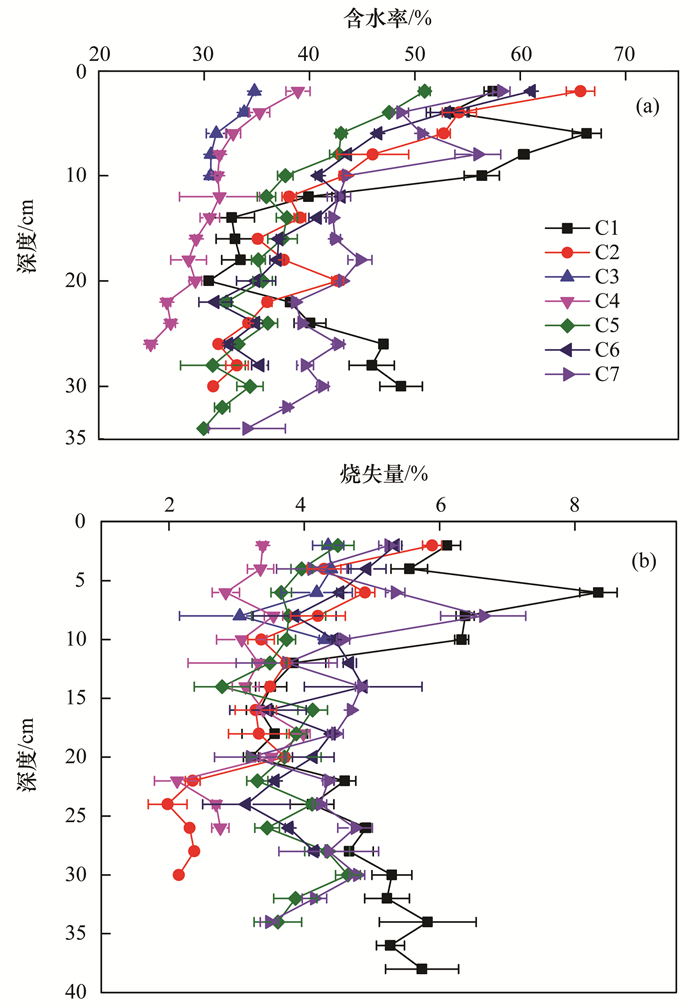
|
图 2 含水率和烧失量的分布特征 Fig. 2 Vertical distribution of moisture content and loss-on-ignition results |
总体而言, 草型湖区胥口湾表层沉积物(0~15 cm)色素含量较高且呈现波动下降的趋势, 水生植物分布区色素含量显著高于无植被区(P < 0.05).其中, 沉积物叶绿素a的含量在0.3~9.0 μg·g-1之间, 平均含量为2.2 μg·g-1; 脱镁叶绿素含量在0.6~36.9 μg·g-1之间, 平均含量为7.8 μg·g-1.表层沉积物叶绿素a(3.1 μg·g-1)和脱镁叶绿素(10.9 μg·g-1)含量约为底层沉积物叶绿素(1.4 μg·g-1)和脱镁叶绿素(4.9 μg·g-1)含量的2倍; 水生植物分布区沉积物叶绿素a(2.4 μg·g-1)和脱镁叶绿素(8.6 μg·g-1)含量分别是无植被区(C3和C4)的3倍和4倍(图 3).
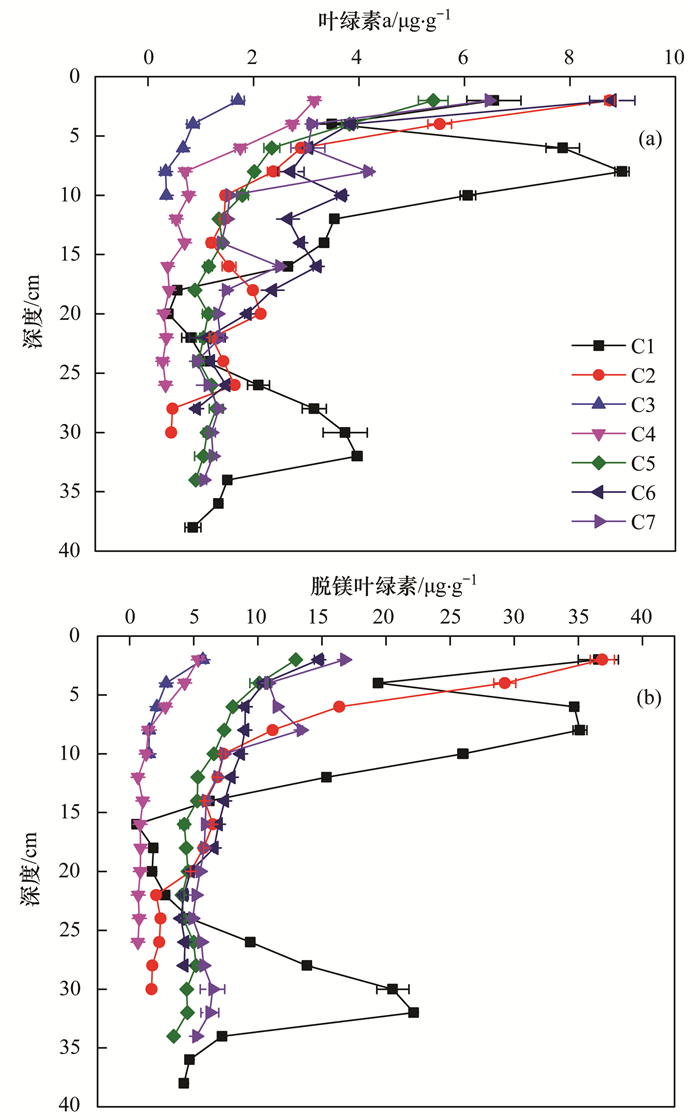
|
图 3 叶绿素a和脱镁叶绿素的垂向变化特征 Fig. 3 Vertical distribution characteristics of Chl-a and phaeopigments |
沉积物中叶绿素a及其降解产物脱镁叶绿素可以为底栖生物提供赖以生存的有机环境, 叶绿素还可以用来表征易降解有机质的量, 通常用叶绿素a与脱镁叶绿素的比值评价有机质的质量[28, 29].富营养化湖泊巢湖沉积物中叶绿素a和脱镁叶绿素含量分别在1.3~27.4 μg·g-1(10.2 μg·g-1)和1.0~32.1 μg·g-1(15.1 μg·g-1)之间[30].由此可见, 藻型湖区的沉积物色素含量显著高于草型湖区, 尤其是叶绿素含量.究其原因可能是藻华暴发期间, 藻类碎屑的沉降速率大于其分解速率[13], 导致大量藻源性有机碎屑的累积促使沉积物色素含量升高.此外, 藻型湖区水体中大量的悬浮颗粒物吸附新鲜藻类沉降到湖底以及底泥中复苏的藻类也会导致沉积物中色素含量的增加[30, 31].
沉积物中碳、氮、磷与色素的分布特征具有高度的一致性.整体表现为表层富集特征, 随底泥深度增加碳、氮、磷含量呈逐渐下降趋势, 且水生植被分布区沉积物TOC和TN含量显著高于无植被区, 而沉积物TP含量差异并不显著.沉积物TOC含量在3.8~66.1 g·kg-1, 平均值为23.4 g·kg-1, 其中, 水生植被分布区沉积物TOC含量(26.7 g·kg-1)是无植被区(8.9 g·kg-1)的3倍(图 4).表明研究区内水生植物碎屑的残体沉降, 显著增加了底泥有机碳的含量.有机碳随深度增加而降低, 可能是由于底层沉积物形成时间久, 在微生物分解、植物吸收和矿化作用下, 导致其含量逐渐降低[32].沉积物TN含量在127.2~2 092.8 mg·kg-1, 平均值为907.8 mg·kg-1, 表层沉积物和底层沉积物TN含量分别为1 037.7 mg·kg-1和798.0 mg·kg-1, 水生植被分布区和无植被区沉积物TN含量分别为1 033.6 mg·kg-1和325.2 mg·kg-1.这与张彦等[33]对太湖东部湖区沉积物TN含量(1 009.4 mg·kg-1)的调查结果较为一致.根据美国环保署(USEPA)制定的沉积物TN评价标准, 沉积物TN含量低于1 000 mg·kg-1属于轻度污染, 介于1 000~2 000 mg·kg-1属于中度污染, 大于2 000 mg·kg-1属于重度污染[34].由此可知, 胥口湾水生植物分布区沉积物TN属于中度污染, 水生植物碎屑在底泥中的富集可能是氮的主要输入源. Wu等[35]的研究也表明生物沉降是太湖草型湖区沉积物中氮的主要来源, 其空间分布主要受风驱动的水动力作用的影响.
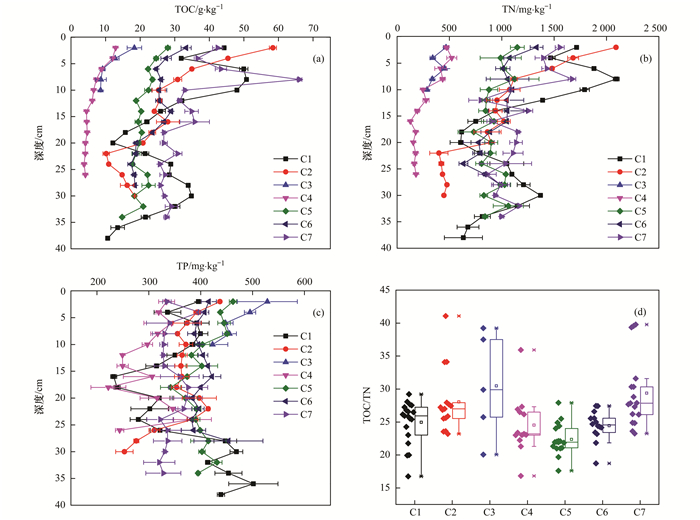
|
图 4 沉积物中碳、氮、磷及碳氮比的分布特征 Fig. 4 Distribution characteristics of TOC, TN, TP, and TOC/TN at different sampling sites |
相比之下, 沉积物TP含量的空间差异并不显著, 表层和底泥沉积物TP含量分别为380.4 mg·kg-1和357.6 mg·kg-1, 水生植物分布区和无植被区沉积物TP含量分别为376.1 mg·kg-1和386.0 mg·kg-1, 这与陈雷等[36]2011年对东太湖的调查的结果(303.2 mg·kg-1)较为一致, 可见水生植物分布对沉积物TP含量的影响并不显著, 同时也间接表明, 随着富营养化程度的加剧, 草型湖区的沉积物磷负荷逐渐增加.根据美国环保署(USEPA)制定的沉积物TP评价标准, 沉积物TP含量低于420 mg·kg-1属于轻度污染, 介于420~650 mg·kg-1属于中度污染, 大于650 mg·kg-1属于重度污染[34].由此可知, 草型湖区胥口湾沉积物TP属于轻度污染, 内源磷负荷较低.
沉积物中TOC/TN值可以反映沉积物营养盐来源, 生物种类不同, TOC/TN值不同.研究表明, 水生高等植物的TOC/TN一般高于20, 而浮游生物的TOC/TN值一般介于4~10之间[37].由图 4(d)可以看出, 胥口湾沉积TOC/TN值变化范围在16.8~41.1之间, 平均值为25.9, 表明胥口湾沉积物中有机质及营养盐主要来源于水生高等植物.
2.3 沉积物中生物易降解有机质的分布特征胥口湾沉积物中生物易降解有机质以糖类为主, 平均含量为3.7 mg·g-1, 其次是脂类(2.8 mg·g-1)和蛋白质(2.3 mg·g-1), 且随沉积物深度增加呈现波动下降的趋势(图 5).水生植被分布区沉积物糖类和蛋白质含量显著高于无植被区, 而脂类含量却无显著差异.究其原因, 一方面是由于太湖沉积物有机质的来源和组成具有显著的空间差异性.研究表明, 水生植物蛋白质和糖类含量相对较高[38], 脂类主要来自硅藻和浮游动物的排泄物[39].在竺山湾和梅梁湾等藻型湖区, 沉积物中有机质主要来源于藻类碎屑和高等植物残体, 而在草型湖区东太湖, 沉积物中有机质主要来源于沉水植物和硅藻[40, 41].另一方面, 不同有机质来源及组分降解速率不同, 导致残留并富于表层沉积物生物易降解有机质组成不同.已有研究表明:不同易降解有机组分降解的难易程度不同, 表现为蛋白质>糖类>脂类[42].在沉降及埋藏过程中, 生物易降解有机质组成及活性不断发生变化, 其中活性有机质优先降解[11], 例如色素, 糖类, 蛋白质等, 而腐殖质等难降解有机质最终被埋藏保留在沉积物中[12].故草型湖区胥口湾沉积物中生物易降解有机质呈现出以糖类占优, 脂类含量次之的特征.此外, 不同类型的有机质矿化产物不同, 对氮素的迁移转化有重要影响.糖类、脂类和纤维素等在降解过程会产生单糖, 最终矿化后释放出CO2和CH4, 而以蛋白质为主的有机物降解后, 最终矿化释放出NH4+-N[33].
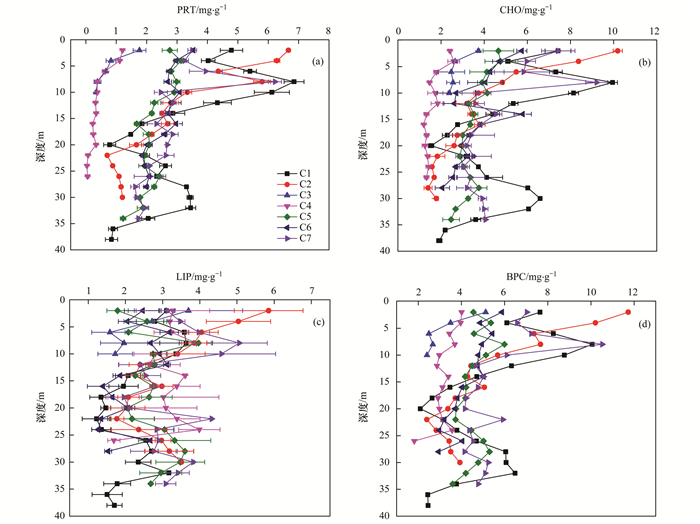
|
图 5 沉积物中生物易降解有机质和生物聚合碳的分布特征 Fig. 5 Vertical distribution characteristics of biodegradable compounds and biopolymeric carbon |
生物聚合碳(BPC)能够代表易被降解利用的有机成分的总量, 通常被用来表征有机质中易降解成分的含量[23, 24].由图 5可知, 研究区沉积物中BPC含量在1.8~11.7 mg·g-1, 平均值为4.7 mg·g-1, 且呈现出表层富集的特征, 与色素和易降解有机质的分布特征具有高度的一致性.根据Pusceddu等[22]制定的沉积物营养状况评价标准, 沉积物中BPC低于1 mg·g-1为贫营养状态, BPC介于1~3 mg·g-1为中营养状态, BPC大于3 mg·g-1属于富营养状态.由此可见, 胥口湾沉积物逐渐由中营养状态向富营养状态过渡, 整体已经趋向于富营养化状态, 在今后的湖泊管理和调控过程中需予以关注.
2.4 碳氮磷及色素与易降解物质的相互关系胥口湾沉积物色素(叶绿素a和脱镁叶绿素)含量与碳氮磷及生物易降解物质均呈现显著正相关(P < 0.01), 表明水生植物碎屑残体是沉积物中营养盐和易降解有机质的主要来源, 这与碳氮比解析的结果一致(表 2).此外, 总有机碳含量与总氮、总糖、总蛋白和总脂含量存在极显著正相关(P < 0.01).这与何延召等[11]对富营养化湖泊巢湖的调查结果相一致, 表明沉积物中总有机碳的含量与生物易降解有机质含量及组成密切相关.近年来, 在富营养化和气候变化的双重影响下, 湖泊生态系统逐渐由草型清水态向藻型浊水态转化, 导致大量水生植物碎屑堆积腐烂, 生物易降解有机质不断积累, 显著改变了湖泊沉积物中有机质的组成, 进而影响湖泊碳循环过程[12, 43].
|
|
表 2 沉积物各指标间的相关系数1)(n=100) Table 2 Pearson correlation coefficients for each index (n=100) |
3 结论
(1) 胥口湾沉积物中色素、碳氮磷及生物易降解物质整体表现为表层富集特征, 主要集中在表层15 cm沉积物.沉积物中氮负荷高于磷负荷, 且存在显著的空间差异性.沉积物TN含量在127.2~2 092.8 mg·kg-1, 沉积物TP含量在222.1~528.4 mg·kg-1, 水生植物分布区氮负荷显著高于无植被区.
(2) 沉积物中生物易降解物质组成上以糖类(3.7 mg·g-1)为主, 其次是脂类(2.8 mg·g-1)和蛋白质(2.3 mg·g-1), 生物聚合碳(BPC)含量在1.8~11.7 mg·g-1, 平均值为4.7 mg·g-1, 且同样呈现出表层富集的特征, 随沉积物深度增加呈现波动下降的趋势.
(3) 水生植物碎屑残体是沉积物中营养盐和易降解有机质的主要来源, 水生植物分布区沉积物中色素、碳氮磷及生物易降解有机质含量均显著高于无植被区(P < 0.01), 胥口湾沉积物逐渐由中营养向富营养状态过渡, 在今后的湖泊管理和调控过程中需予以关注.
| [1] |
吴庆龙, 邢鹏, 李化炳, 等. 草藻型稳态转换对湖泊微生物结构及其碳循环功能的影响[J]. 微生物学通报, 2013, 40(1): 87-97. Wu Q L, Xing P, Li H B, et al. Impacts of regime shift between phytoplankton and macrophyte on the microbial community structure and its carbon cycling in lakes[J]. Microbiology China, 2013, 40(1): 87-97. |
| [2] | Dean W E, Gorham E. Magnitude and significance of carbon burial in lakes, reservoirs, and peatlands[J]. Geology, 1998, 26(6): 535-538. DOI:10.1130/0091-7613(1998)026<0535:MASOCB>2.3.CO;2 |
| [3] | Tranvik L J, Downing J A, Cotner J B, et al. Lakes and reservoirs as regulators of carbon cycling and climate[J]. Limnology and Oceanography, 2009, 54(6): 2298-2314. |
| [4] | Xu F L, Yang C, He W, et al. Bias and association of sediment organic matter source apportionment indicators:a case study in a eutrophic Lake Chaohu, China[J]. Science of the Total Environment, 2017, 581-582: 874-884. DOI:10.1016/j.scitotenv.2017.01.037 |
| [5] | Chen X C, Feng M H, Fan K, et al. Source and biogeochemical distribution of organic matter in surface sediment in the deep oligotrophic Lake Fuxian, China[J]. Aquatic Geochemistry, 2018, 24(1): 55-77. DOI:10.1007/s10498-018-9330-5 |
| [6] | Pusceddu A, Dell'Anno A, Fabiano M, et al. Quantity and bioavailability of sediment organic matter as signatures of benthic trophic status[J]. Marine Ecology Progress, 2009, 375: 41-52. DOI:10.3354/meps07735 |
| [7] |
李文朝, 陈开宁, 吴庆龙, 等. 东太湖水生植物生物质腐烂分解实验[J]. 湖泊科学, 2001, 13(4): 331-336. Li W C, Chen K N, Wu Q L, et al. Experimental studies on decomposition process of aquatic plant material from East Taihu Lake[J]. Journal of Lake Sciences, 2001, 13(4): 331-336. DOI:10.3321/j.issn:1003-5427.2001.04.006 |
| [8] |
李柯, 关保华, 刘正文. 蓝藻碎屑分解速率及氮磷释放形态的实验分析[J]. 湖泊科学, 2011, 23(6): 919-925. Li K, Guan B H, Liu Z W. Experiments on decomposition rate and release forms of nitrogen and phosphorus from the decomposing cyanobacterial detritus[J]. Journal of Lake Sciences, 2011, 23(6): 919-925. |
| [9] | Shilla D, Asaeda T, Fujino T, et al. Decomposition of dominant submerged macrophytes:implications for nutrient release in Myall Lake, NSW, Australia[J]. Wetlands Ecology and Management, 2006, 14(5): 427-433. DOI:10.1007/s11273-006-6294-9 |
| [10] | Zhou X H, Wang G X. Nutrient concentration variations during Oenanthe javanica growth and decay in the ecological floating bed system[J]. Journal of Environmental Sciences, 2010, 22(11): 1710-1717. DOI:10.1016/S1001-0742(09)60310-7 |
| [11] |
何延召, 柯凡, 冯慕华, 等. 巢湖表层沉积物中生物易降解物质成分特征与分布规律[J]. 湖泊科学, 2016, 28(1): 40-49. He Y Z, Ke F, Feng M H, et al. Characteristics and distribution of biodegradable compounds of surface sediments in Lake Chaohu[J]. Journal of Lake Sciences, 2016, 28(1): 40-49. |
| [12] |
刘新, 黄庆慧, 江和龙, 等. 浅水湖泊沉积物中水生植物残体降解过程及微生物群落变化[J]. 生态环境学报, 2016, 25(3): 489-495. Liu X, Huang Q H, Jiang H L, et al. The decomposition processes of aquatic plant residue and the change of microbial community structure in a shallow lake sediment[J]. Ecology and Environmental Sciences, 2016, 25(3): 489-495. |
| [13] |
祁闯, 王国祥, 吴馨婷, 等. 太湖湖滨带春季悬浮物沉降特征与水体营养盐响应[J]. 环境科学, 2017, 38(1): 95-103. Qi C, Wang G X, Wu X T, et al. Deposition characteristics of suspended solids and the response of dissolved nutrients in spring in the western lakeside of Taihu Lake[J]. Environmental Science, 2017, 38(1): 95-103. |
| [14] | Qi C, Xu X G, Shi K, et al. In situ resuspension rate monitoring method in the littoral zone with multi-ecotypes of a shallow wind-disturbed lake[J]. Environmental Science and Pollution Research, 2019, 26(8): 7476-7485. DOI:10.1007/s11356-018-04059-0 |
| [15] | Qi C, Zhou Y, Xu X G, et al. Dynamic monitoring of resuspension in the multiple eco-types of the littoral zone of a shallow wind-disturbed lake[J]. Aquatic Sciences, 2019, 81(2): 33. DOI:10.1007/s00027-019-0620-9 |
| [16] |
谷孝鸿, 张圣照, 白秀玲, 等. 东太湖水生植物群落结构的演变及其沼泽化[J]. 生态学报, 2005, 25(7): 1541-1548. Gu X H, Zhang S Z, Bai X L, et al. Evolution of community structure of aquatic macrophytes in East Taihu Lake and its wetlands[J]. Acta Ecologica Sinica, 2005, 25(7): 1541-1548. DOI:10.3321/j.issn:1000-0933.2005.07.002 |
| [17] | Chuai X M, Ding W, Chen X F, et al. Phosphorus release from cyanobacterial blooms in Meiliang Bay of Lake Taihu, China[J]. Ecological Engineering, 2011, 37(6): 842-849. DOI:10.1016/j.ecoleng.2011.01.001 |
| [18] |
朱梦圆, 朱广伟, 王永平. 太湖蓝藻水华衰亡对沉积物氮、磷释放的影响[J]. 环境科学, 2011, 32(2): 409-415. Zhu M Y, Zhu G W, Wang Y P. Influence of scum of algal bloom on the release of N and P from sediments of Lake Taihu[J]. Environmental Science, 2011, 32(2): 409-415. |
| [19] |
尚丽霞, 柯凡, 李文朝, 等. 高密度蓝藻厌氧分解过程与污染物释放实验研究[J]. 湖泊科学, 2013, 25(1): 47-54. Shang L X, Ke F, Li W C, et al. Laboratory research on the contaminants release during the anaerobic decomposition of high-density cyanobacteria[J]. Journal of Lake Science, 2013, 25(1): 47-54. DOI:10.3969/j.issn.1003-5427.2013.01.007 |
| [20] | Venturini N, Pita A L, Brugnoli E, et al. Benthic trophic status of sediments in a metropolitan area (Rio de la Plata estuary):linkages with natural and human pressures[J]. Estuarine, Coastal and Shelf Science, 2012, 112: 139-152. DOI:10.1016/j.ecss.2011.08.016 |
| [21] | Yin X W, Min W W, Lin H J, et al. Population dynamics, protein content, and lipid composition of Brachionus plicatilis fed artificial macroalgal detritus and Nannochloropsis sp. Diets[J]. Aquaculture, 2013, 380-383: 62-69. DOI:10.1016/j.aquaculture.2012.11.018 |
| [22] | Pusceddu A, Bianchelli S, Gambi C, et al. Assessment of benthic trophic status of marine coastal ecosystems:significance of meiofaunal rare taxa[J]. Estuarine, Coastal and Shelf Science, 2011, 93(4): 420-430. DOI:10.1016/j.ecss.2011.05.012 |
| [23] | Salas P M, Sujatha C H, Kumar C S R. Fate and source distribution of organic constituents in a river-dominated tropical estuary[J]. Journal of Earth System Science, 2015, 124(6): 1265-1279. DOI:10.1007/s12040-015-0598-1 |
| [24] | Mathew J, Gopinath A, Martin G D. Spatial and temporal distribution in the biochemical composition of sedimentary organic matter in a tropical estuary along the west coast of India[J]. SN Applied Sciences, 2019, 1(2): 150. DOI:10.1007/s42452-018-0128-2 |
| [25] |
刘子亭, 余俊清, 张保华, 等. 烧失量分析在湖泊沉积与环境变化研究中的应用[J]. 盐湖研究, 2006, 14(2): 67-72. Liu Z T, Yu J Q, Zhang B H, et al. Application of loss on ignition to the study of lake sediments and environmental changes[J]. Journal of Salt Lake Research, 2006, 14(2): 67-72. DOI:10.3969/j.issn.1008-858X.2006.02.013 |
| [26] |
马久远.典型水生植物对沉积物中氮素形态及分布的影响[D].南京: 南京师范大学, 2014. Ma J Y. The influence on transformation and distribution of nitrogen in the sediment by Aquatic plants[D]. Nanjing: Nanjing Normal University, 2014. http://cdmd.cnki.com.cn/Article/CDMD-10319-1014342957.htm |
| [27] | Qin B Q, Hu W P, Gao G, et al. Dynamics of sediment resuspension and the conceptual schema of nutrient release in the large shallow Lake Taihu, China[J]. Chinese Science Bulletin, 2004, 49(1): 54-64. DOI:10.1007/BF02901743 |
| [28] | Dell'Anno A, Mei M L, Pusceddu A, et al. Assessing the trophic state and eutrophication of coastal marine systems:a new approach based on the biochemical composition of sediment organic matter[J]. Marine Pollution Bulletin, 2002, 44(7): 611-622. DOI:10.1016/S0025-326X(01)00302-2 |
| [29] | Wieking G, Kröncke I. Is benthic trophic structure affected by food quality? The Dogger Bank example[J]. Marine Biology, 2005, 146(2): 387-400. DOI:10.1007/s00227-004-1443-2 |
| [30] | 何延召.典型浅水湖泊湖底藻源性有机碎屑的理化特征及其降解研究[D].北京: 中国科学院大学, 2015. http://www.wanfangdata.com.cn/details/detail.do?_type=degree&id=Y2852133 |
| [31] |
谢小萍, 李亚春, 杭鑫, 等. 气温对太湖蓝藻复苏和休眠进程的影响[J]. 湖泊科学, 2016, 28(4): 818-824. Xie X P, Li Y C, Hang X, et al. The effect of air temperature on the process of cyanobacteria recruitment and dormancy in Lake Taihu[J]. Journal of Lake Sciences, 2016, 28(4): 818-824. |
| [32] |
杨超, 谷孝鸿, 曾庆飞, 等. 东太湖沉积物中磷的形态分布特征研究[J]. 水生态学杂志, 2012, 33(1): 5-8. Yang C, Gu X H, Zeng Q F, et al. Phosphorus fractions and distribution in sediments of East Taihu Lake[J]. Journal of Hydroecology, 2012, 33(1): 5-8. |
| [33] |
张彦, 张远, 于涛, 等. 太湖沉积物及孔隙水中氮的时空分布特征[J]. 环境科学研究, 2010, 23(11): 1333-1342. Zhang Y, Zhang Y, Yu T, et al. Spatial and temporal distribution of nitrogen species in sediment and interstitial waters of Taihu Lake[J]. Research of Environmental Sciences, 2010, 23(11): 1333-1342. |
| [34] | MacDonald D D, Ingersoll C G. A guidance manual to support the assessment of contaminated sediments in freshwater ecosystems[R]. Washington: United States Environmental Protection Agency, 2002. |
| [35] | Wu T F, Qin B Q, Brookes J D, et al. Spatial distribution of sediment nitrogen and phosphorus in Lake Taihu from a hydrodynamics-induced transport perspective[J]. Science of the Total Environment, 2019, 650: 1554-1565. DOI:10.1016/j.scitotenv.2018.09.145 |
| [36] |
陈雷, 远野, 卢少勇, 等. 环太湖主要河流入出湖口表层沉积物污染特征研究[J]. 中国农学通报, 2011, 27(1): 294-299. Chen L, Yuan Y, Lu S Y, et al. The analysis of pollutant characteristics in surface sediments of the stream inlets and outlets of the main rivers around Taihu Lake[J]. Chinese Agricultural Science Bulletin, 2011, 27(1): 294-299. |
| [37] | Meyers P A, Ishiwatari R. Lacustrine organic geochemistry-an overview of indicators of organic matter sources and diagenesis in lake sediments[J]. Organic Geochemistry, 1993, 20(7): 867-900. DOI:10.1016/0146-6380(93)90100-P |
| [38] |
杨柳燕, 张奕, 肖琳, 等. 固体发酵提高水生植物发酵产物蛋白含量的研究[J]. 环境科学学报, 2007, 27(1): 35-39. Yang L Y, Zhang Y, Xiao L, et al. Improvement of crude protein content in aquatic macrophyte by solid-state fermentation[J]. Acta Scientiae Circumstantiae, 2007, 27(1): 35-39. DOI:10.3321/j.issn:0253-2468.2007.01.007 |
| [39] | Baldi F, Marchetto D, Pini F, et al. Biochemical and microbial features of shallow marine sediments along the Terra Nova Bay (Ross Sea, Antarctica)[J]. Continental Shelf Research, 2010, 30(15): 1614-1625. DOI:10.1016/j.csr.2010.06.009 |
| [40] | Zhang Y D, Su Y L, Liu Z W, et al. Lipid biomarker evidence for determining the origin and distribution of organic matter in surface sediments of Lake Taihu, Eastern China[J]. Ecological Indicators, 2017, 77: 397-408. DOI:10.1016/j.ecolind.2017.02.031 |
| [41] | Zhang Y D, Su Y L, Liu Z W, et al. Aliphatic hydrocarbon biomarkers as indicators of organic matter source and composition in surface sediments from shallow lakes along the lower Yangtze River, Eastern China[J]. Organic Geochemistry, 2018, 122: 29-40. DOI:10.1016/j.orggeochem.2018.04.009 |
| [42] | Joseph M M, Kumar C S R, Kumar T R G, et al. Biogeochemistry of surficial sediments in the intertidal systems of a tropical environment[J]. Chemistry and Ecology, 2008, 24(4): 247-258. DOI:10.1080/02757540802119871 |
| [43] | Hilt S, Brothers S, Jeppesen E, et al. Translating regime shifts in shallow lakes into changes in ecosystem functions and services[J]. Bioscience, 2017, 67(10): 928-936. DOI:10.1093/biosci/bix106 |
 2019, Vol. 40
2019, Vol. 40


